In the avian world, distinguishing between similar bird species can be a challenging task. Cowbirds and grackles, with their overlapping appearances, pose such a challenge.
However, by paying attention to specific physical characteristics, behaviors, and habitats, and utilizing reliable resources, birdwatchers can successfully differentiate between these two species.
Still, if you don’t have a proper idea about these two species, it will be difficult for you to differentiate them, especially when they are in nature. Here are the common criteria and differences between these two bird species.
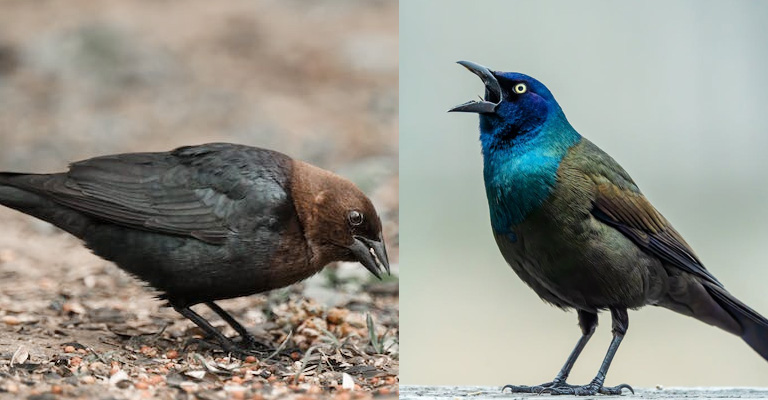
Physical Characteristics: Cowbird Vs Grackle
The very first thing you need to check while identifying Cowbirds and Grackles is their physical appearance. You should check the following facts in this case.
Size and Tail Length
When it comes to distinguishing between cowbirds and grackles, one of the key factors to consider is their size and tail length. While they may share some similarities in appearance, their proportions differ in noticeable ways.
Description of the Relative Sizes of Cowbirds and Grackles:
Cowbirds tend to be smaller in size compared to grackles. Adult cowbirds typically measure around 7-8 inches (18-20 cm) in length, while grackles are larger, ranging from 11-13 inches (28-33 cm) in length.
This difference in size becomes evident when observing these birds side by side.
Differentiating Features of Their Tail Lengths:
Another characteristic to focus on is the length of their tails. Cowbirds have relatively shorter tails compared to grackles. The tail of a cowbird appears less elongated, usually reaching a length of around 3-4 inches (7-10 cm).
In contrast, grackles possess longer tails, which extend further, measuring approximately 6-8 inches (15-20 cm) in length. This disparity in tail length can be a helpful indicator when trying to distinguish between the two species.
Head Color: Cowbird Vs Grackle
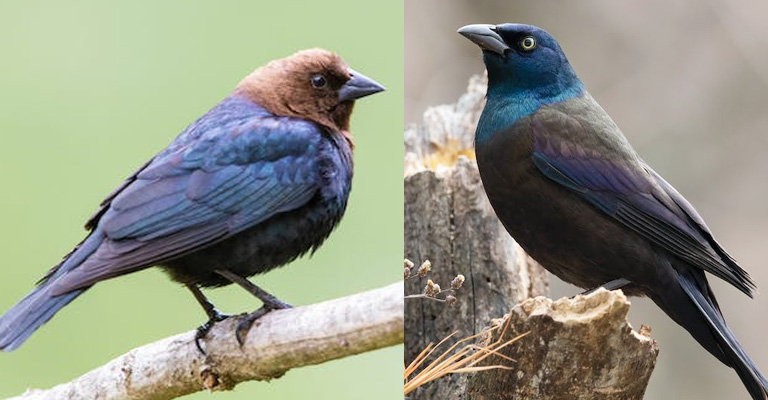
Cowbirds and Grackle don’t share similarities in their feather and hair color. You can easily identify them by their color as well. Make sure to check the following criteria.
The Head Color Differences in Male Cowbirds and Grackles
The coloration of the head is a prominent distinguishing feature between male cowbirds and grackles. While both species exhibit distinct head colors, there are noticeable variations that can aid in identification.
Male cowbirds typically have a brown head. The shade of brown can vary between individuals, ranging from light to dark brown. This coloration extends across the entire head, creating a uniform appearance.
In contrast, male grackles display a bluish head. The blue hue can range from deep navy to iridescent shades, depending on the lighting conditions.
This striking contrast in head coloration between cowbirds and grackles serves as a reliable indicator when attempting to differentiate between the two species.
How to Distinguish Them on Head Color
Within the cowbird species, there is an additional distinction to be made based on head color. While male cowbirds have brown heads, female cowbirds, as well as juvenile individuals, possess different head colors.
Females and juveniles exhibit lighter brown or grayish-brown heads, often contrasting with their body coloration. Grackles maintain their bluish head coloration throughout their lifespan. This consistent blue hue can help distinguish grackles from both male and female cowbirds.
Eye Color: Cowbird Vs Grackle
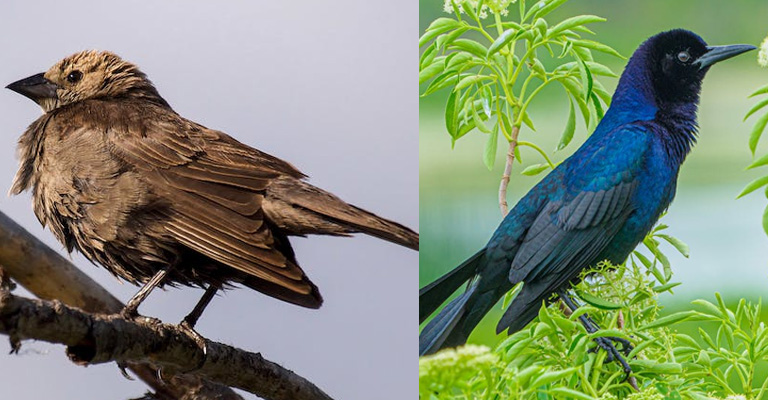
Though it is often difficult to check their eye color, it is another place where they have a big difference. Here is how you can differentiate them by checking their eye color.
Highlighting the Distinctive Eye Colors
Eye color is another important characteristic that can aid in differentiating between cowbirds and grackles. Each species possesses a unique eye coloration that sets them apart from one another.
Common grackles typically have yellowish or golden eyes. These bright, vibrant eye colors stand out against the dark feathers of the grackle. The yellow or golden hue adds to their overall striking appearance.
In contrast, cowbirds, including the brown-headed cowbird, have dark or black eyes. The dark eye coloration creates a noticeable contrast against their plumage.
This feature can be particularly helpful in distinguishing cowbirds from grackles, as the difference in eye color is distinct and consistent across individuals within each species.
Observing Eye Color for Accurate Identification
Observing eye color is crucial for the accurate identification of cowbirds and grackles. While other physical characteristics may overlap or vary within a species, eye color is often a reliable and consistent indicator.
By paying close attention to the eye color of the bird in question, birdwatchers can confidently determine whether they are observing a grackle with yellowish or golden eyes or a cowbird with dark or black eyes.
This additional detail strengthens the overall identification process and reduces the likelihood of misidentifying these similar-looking species.
As with any identification, it is important to consider multiple characteristics together to ensure accurate identification.
However, the distinct eye colors of cowbirds and grackles serve as a valuable clue, reinforcing the identification process and enabling birdwatchers to confidently differentiate between these two species.
Bill Shape: Cowbird Vs Grackle
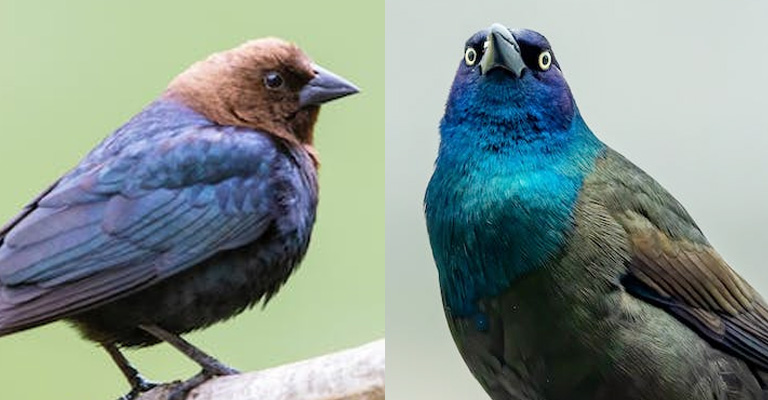
These two tiny creatures also have specifications in their bill sizes. So, you can check their bill to identify them when you are not sure still after checking their color, physical appearance, etc.
Comparing the Bill Shapes of Grackles and Cowbirds
The bill shape is another useful characteristic when distinguishing between grackles and cowbirds. While both species have similar-sized bills, there are notable differences in their structures that can aid in identification.
Grackles, including common grackles and boat-tailed grackles, have long, slender bills. Their bills are slightly curved and pointed, allowing them to efficiently probe and search for food in the ground or other substrates.
This elongated bill shape is well-suited for their foraging habits and provides a distinct feature for identifying grackles.
On the other hand, cowbirds, such as brown-headed cowbirds, have a conical bill shape. Their bills are shorter, thicker, and blunter compared to the bills of grackles.
This conical structure gives cowbirds a different appearance when compared to grackles. It is important to note that this distinct bill shape is not exclusive to brown-headed cowbirds but is generally characteristic of cowbird species.
Differences in Bill Structure
The differences in bill shape between grackles and cowbirds can aid in identification, especially when observing these birds up close.
The long, slender, and pointed bill of grackles is a distinguishing feature that aligns with their foraging behavior and can help confirm their identification.
Conversely, the shorter, thicker, and blunter conical bill of cowbirds sets them apart from grackles. This bill shape reflects their feeding habits and can be used to differentiate them from similar-looking species.
By paying attention to the billing structure, birdwatchers can further refine their identification process.
Combining observations of bill shape with other characteristics, such as head color, eye color, and size, enhances the accuracy of distinguishing between grackles and cowbirds.
Behavioral Patterns: Cowbird Vs Grackle
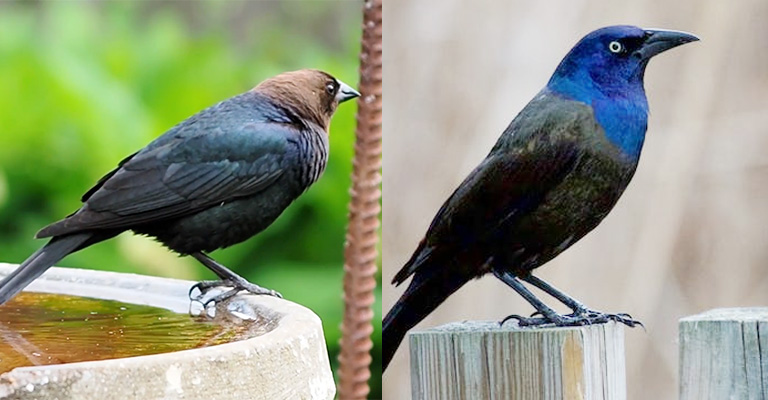
Additionally, Cowbirda and Grackles have differences in their behavior as well. If you somehow used to pet them you can find differences in the following facts.
Foraging Behavior
Both cowbirds and grackles are omnivorous birds and have similar diets that include a variety of foods such as seeds, grains, fruits, insects, and small vertebrates.
They are opportunistic feeders and can adapt to different food sources depending on availability.
Grackles are known for their ground-foraging behavior. They often gather in large flocks and use their long, slender bills to probe the soil or search for food in open areas, lawns, and agricultural fields.
Grackles may also feed on insects and fruits found in trees and shrubs. Cowbirds, on the other hand, tend to forage more in open habitats, such as grasslands and pastures. They are often seen foraging on the ground, searching for insects and seeds.
Additionally, cowbirds exhibit a unique behavior known as brood parasitism. Female cowbirds lay their eggs in the nests of other bird species, relying on these host species to raise their young.
Notable Behaviors That Can Help Differentiate Between the Two Species:
While both cowbirds and grackles share some similarities in foraging behavior, there are behaviors that can help distinguish between them.
Grackles’ preference for ground foraging and their larger flock sizes may be observed more frequently in open areas, while cowbirds may be encountered in grasslands or pastures where they feed on the ground.
Additionally, the unique brood parasitism behavior exhibited by cowbirds is a behavior not seen in grackles or other bird species.
By observing the foraging behaviors and other distinctive behaviors of these birds, birdwatchers can gather valuable clues to accurately identify whether they are observing a cowbird or a grackle in their natural habitats.
Nesting Behavior: Cowbird Vs Grackle
Eventually, these two bird species have notable distinguishing facts in their nesting behavior. The following facts will definitely surprise you.
Cowbird Nesting Patterns
Cowbirds, such as the brown-headed cowbird, do not build their own nests. Instead, they rely on other bird species to raise their young. Female cowbirds lay their eggs in the nests of other birds, which then incubate and care for the cowbird eggs and fledglings.
This behavior is known as brood parasitism. Cowbirds have evolved this strategy as an adaptation to ensure the survival of their offspring.
The cowbird eggs are often laid in the nests of smaller songbirds. Once hatched, the cowbird nestlings outcompete the host species’ own young for food resources, often resulting in the host species raising the cowbird chick at the expense of their own offspring.
Grackle Nesting Patterns
Grackles, unlike cowbirds, engage in more traditional nesting behaviors. They build their own nests and are responsible for incubating their eggs and raising their young.
Grackles, such as common grackles and boat-tailed grackles, construct cup-shaped nests using twigs, grass, and other materials. These nests are usually located in trees or shrubs, providing protection and concealment for the eggs and nestlings.
Grackles are attentive parents, actively participating in incubation and feeding their young until they fledge.
By contrasting cowbird nesting behavior with grackle nesting patterns, it becomes evident that cowbirds have a unique reproductive strategy relying on brood parasitism, while grackles exhibit more conventional nesting behaviors.
Observing nesting habits and understanding these distinct behaviors can aid in differentiating between cowbirds and grackles when observing their reproductive activities in the field.
Range and Habitat
As usual, Cowbird and Grackle prefer different ranges and habitats. The following factors simply distinguish them in this context.
Geographic Distribution
Understanding the geographic distribution of cowbirds and grackles is important for accurately identifying and distinguishing between the two species.
While they may have overlapping ranges in certain areas, there are specific regions where each species is more commonly found.
Identifying the Regions Where Cowbirds and Grackles Are Commonly Found:
Cowbirds, including the brown-headed cowbird, have a relatively wide distribution across North America. They can be found throughout much of the United States, southern Canada, and parts of Mexico.
Within their range, they occupy a variety of habitats, including grasslands, pastures, open woodlands, and even urban areas.
Grackles, such as common grackles and boat-tailed grackles, are also widespread across North America. They are primarily found in the eastern and central regions of the United States, ranging from the Atlantic Coast to the Great Plains.
They are adaptable birds that thrive in diverse habitats, including wetlands, forests, suburban areas, and agricultural fields.
Noting any overlapping ranges and potential areas of confusion:
There are regions where the ranges of cowbirds and grackles overlap, which can lead to potential areas of confusion during identification. In some parts of the United States, especially in the eastern and central regions, both cowbirds and grackles can be found in similar habitats.
In areas of overlap, it is important to rely on other distinguishing characteristics, such as size, head color, eye color, and bill shape, to accurately identify the species.
Careful observation and consideration of these features, combined with knowledge of the specific range and habitat preferences of each species, can help birdwatchers differentiate between cowbirds and grackles in areas where they coexist.
By being aware of the typical ranges and habitats of cowbirds and grackles, birdwatchers can narrow down their identification possibilities and make more informed judgments when encountering these species in the field.
Preferred Habitats: Cowbird Vs Grackle
Cowbirds and Grackle also share some specific dissimilarities in their habitats. Here are the points where they are not the same.
The Habitats Preferred by Cowbirds and Grackles
Understanding the preferred habitats of cowbirds and grackles is essential for accurate identification and species differentiation.
While there may be some overlap in habitat selection, each species tends to exhibit certain habitat preferences.
Describing Cowbird Habitats:
Cowbirds, such as the brown-headed cowbird, are adaptable and can be found in a variety of habitats across their range.
They are commonly associated with open habitats, including grasslands, pastures, agricultural fields, and meadows.
Cowbirds also thrive in areas where there is a mix of open spaces and patches of shrubs or trees, as these provide suitable foraging and nesting opportunities.
Describing Grackle Habitats:
Grackles, including common grackles and boat-tailed grackles, have a broad range of habitat preferences. They are commonly found in wetland areas, including marshes, swamps, and the edges of ponds and lakes.
Grackles also inhabit forested areas, suburban neighborhoods, and agricultural fields. They are versatile birds that can adapt to both urban and rural environments.
How Habitat Preferences Can Assist in Species Identification:
The understanding of habitat preferences can be a valuable tool in species identification, as it provides additional context for distinguishing between cowbirds and grackles.
By observing the habitat where a bird is present, birdwatchers can gain important insights. For example, if the bird is in a wetland or marshy area, it is more likely to be a grackle, as they tend to favor these habitats.
Identification Tips and Resources
Now, let’s come to the points that will help you understand their criteria and differences instantly. Check the following tips to distinguish them easily.
Key Identification Points
To facilitate the accurate identification of cowbirds and grackles, it is important to summarize the main distinguishing characteristics between these species.
By focusing on key identification points, birdwatchers can confidently differentiate between the two.
Summarizing the main distinguishing characteristics of cowbirds and grackles
- Size and Tail Length: Cowbirds are generally smaller with shorter tails compared to grackles.
- Head Color: Male cowbirds have a brown head, while grackles have a bluish head.
- Eye Color: Grackles typically have yellowish or golden eyes, while cowbirds have dark or black eyes.
- Bill Shape: Grackles have long, slender bills, while cowbirds have shorter, thicker, and blunter conical bills.
- Nesting Behavior: Cowbirds exhibit brood parasitism, laying their eggs in the nests of other birds, while grackles build their own nests.
Providing a Quick Reference Guide for Accurate Identification
To aid in accurate identification, birdwatchers can use field guides and online resources specifically dedicated to bird identification.
Field guides provide detailed descriptions, illustrations, and range maps for cowbirds and grackles, making them valuable references when observing these species in the field.
Cowbirds Vs. Grackles: At A Glance
| Cowbirds | Grackles |
| Smaller size | Larger size |
| Shorter tail | Longer tail |
| Brown head (male) | Bluish head (male) |
| Black eyes | Yellowish/golden eyes |
| Conical bill shape | Long, slender bill shape |
| Brood parasitism behavior | Build their own nests |
| Ground foraging | Ground and tree foraging |
| Open habitats preference | Wetlands and forest edges |
| Found in grasslands | Found in urban areas |
| Smaller flocks | Larger flocks |
| Prefer grassy areas | Prefer wetland areas |
| Nest in other birds’ nests | Build cup-shaped nests |
| Lighter head color in females/juveniles | Blue head in both sexes |
| Short, thick neck | Long, slender neck |
| Lack of iridescent feathers | Iridescent feathers in some species |
| Laid-back posture when perched | Upright posture when perched |
| More varied diet | Primarily insectivorous |
| Males have less pronounced vocalizations | Males have distinct vocalizations |
| Found in North America | Found in North America and parts of Mexico |
| Tendency to associate with livestock | Tendency to associate with wetland habitats |
FAQs
Yes, both cowbirds and grackles have distinctive behaviors and vocalizations. Cowbirds are known for their brood parasitism behavior, laying their eggs in the nests of other bird species.
Grackles, on the other hand, are known for their raucous calls and are often heard making a variety of loud and harsh vocalizations.
Yes, cowbirds and grackles can coexist in the same habitat, especially in areas with suitable foraging and nesting opportunities. They may even be seen foraging together in mixed flocks, although they still maintain their species-specific behaviors and characteristics.
Yes, there are physical differences between male and female cowbirds and grackles. In cowbirds, male and female adults have similar body shapes and colors, with males having brown heads.
Female cowbirds and juveniles have a lighter brown or grayish-brown heads. In Grackles, males and females share similar body shapes and colors, with both sexes having bluish heads.
Cowbirds and grackles can exhibit both migratory and resident populations. Some individuals may migrate seasonally, while others may stay in the same area year-round, depending on their specific geographic location and the availability of resources.
Wrapping Up
Accurately identifying cowbirds and grackles requires attention to key distinguishing features such as size, head color, eye color, bill shape, and nesting behavior.
Though it is often difficult to identify them, their differences are clear and specific. By observing these distinct characteristics, birdwatchers can confidently differentiate between these similar yet distinct bird species.
Hopefully, this guide will help you understand the basic differences between these two bird species. Thank you for reading this blog.